The international fixtures returned as Argentina hosted Paraguay in Buenos Aires in what was the third game of 2022 FIFA World Cup qualification (CONMEBOL). The guests took the lead thanks to Ángel Romero’s penalty goal at the 21st minute and Argentina then fought hard to equalise before halftime but ultimately could not bag another goal in the remaining time.
This tactical analysis dissects the tactics of Scaloni and Eduardo Berizzo as both managers had prepared to try exploiting the oppositions strategically.
Lineups
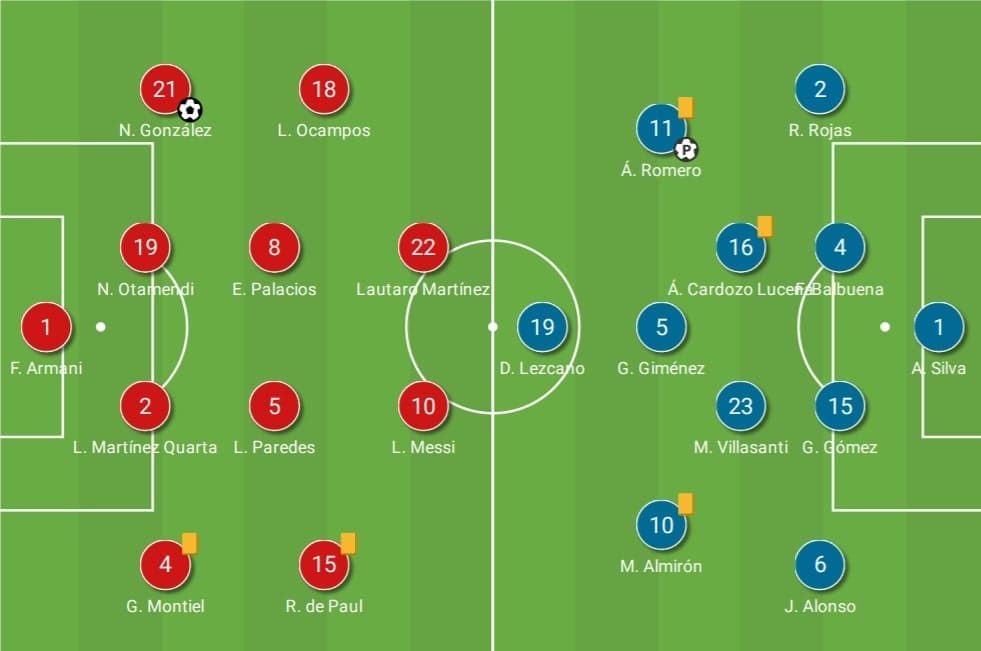
Argentina were without several players previously preferred by Scaloni, for example, Marcos Acuña from Sevilla and Nicolás Tagliafico from Ajax. Nicolás González took the left-back position while Lucas Ocampos played as the left-winger, allowing Leandro Paredes to be partnered with Exequiel Palacios at the midfield.
Paraguay have some familiar names, including Premier League players Fabián Balbuena and Miguel Almirón. However, Matías Rojas, the attacking player from Racing Club, did not participate in this game while Real Betis player Antonio Sanabria only played four minutes as a substitute.
Argentina positional plays and left overload
As usual, Argentina were trying to play out from the back given the technical players they possessed. The attacking structure was more than just a shape as Lionel Messi would always roam his position, while the rest should move to create spaces for the best player of the team. The very basic setup would be a 2-1 shape with Paredes playing in front of the centre-backs while the full-backs were expected to provide the width on both flanks.
However, Paraguay were smart to commit at least a player to shadow Paredes all the time. This strategy has given a more difficult build-up phase to Argentina, as they could not construct the attack through the pivot or at the centre of the pitch. Argentina had to find other ways to play out from the back, such as dropping another player – Rodrigo de Paul or Giovani Lo Celso to receive the ball. They could also go sideways by playing to the full-backs, such as the Nicolás Otamendi -> González route below.
But here was another issue. When the pass carried too much verticality, the receiver closed his body, and hence why the Paraguay players had to aggressively pressure from the back. The attacking players could never turn on those occasions. The team would require the third man to progress, but the midfielders were not supportive enough or not synchronizing the movements. Lo Celso’s positioning was unable to open a passing lane for González in this example. Therefore, most return passes resulted in circulation at the back instead of instant progression to advanced areas.
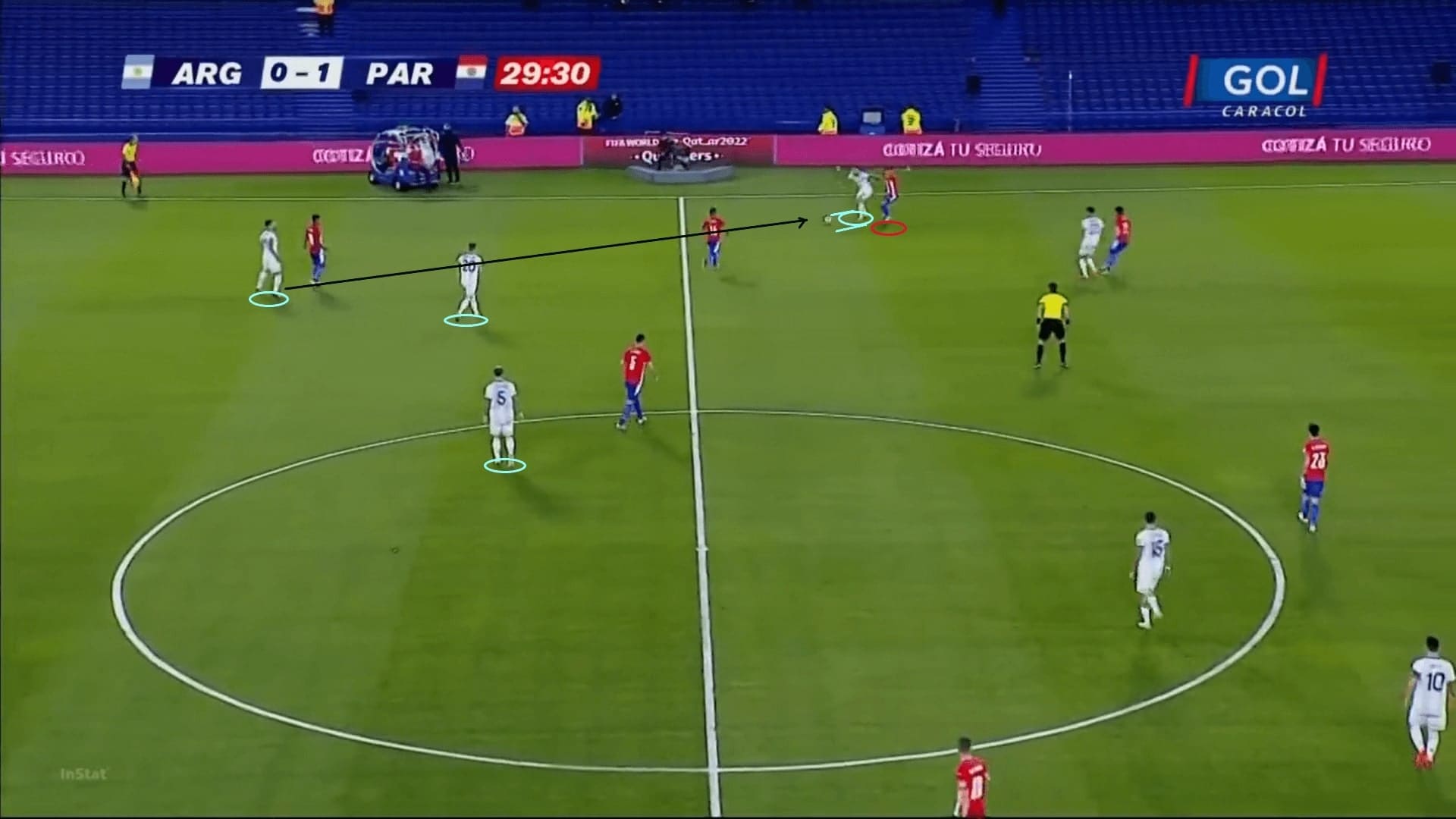
The best way for Argentina to reach the final third was to rely on the ball-playing ability of centre-backs. Otamendi and Lucas Martínez Quarta were permitted to bring the ball forward or even dribbling past the oppositions. This ball-carry action was vital to break the first line of Paraguay as Paredes was often unavailable.
To create spaces for the centre-backs by manipulating the pressuring height of the oppositions, Palacios tended to stay behind of the midfield to control the second line. Meanwhile, Ocampos was always ready to attack the spaces behind the right-back, waiting for the release pass. Their positions are shown in the below image.
Here, Paredes pinned the striker at the centre, allowing Otamendi to bring the ball forward, who also would draw the defending player out of position. Palacios should try staying behind the midfield and wait for the pass, then, he could have a lot of spaces to turn by utilising spaces between the lines. Ocampos or González could then quickly be released in zone 16 to provide the crosses, and he would have to time his run to avoid being offside.
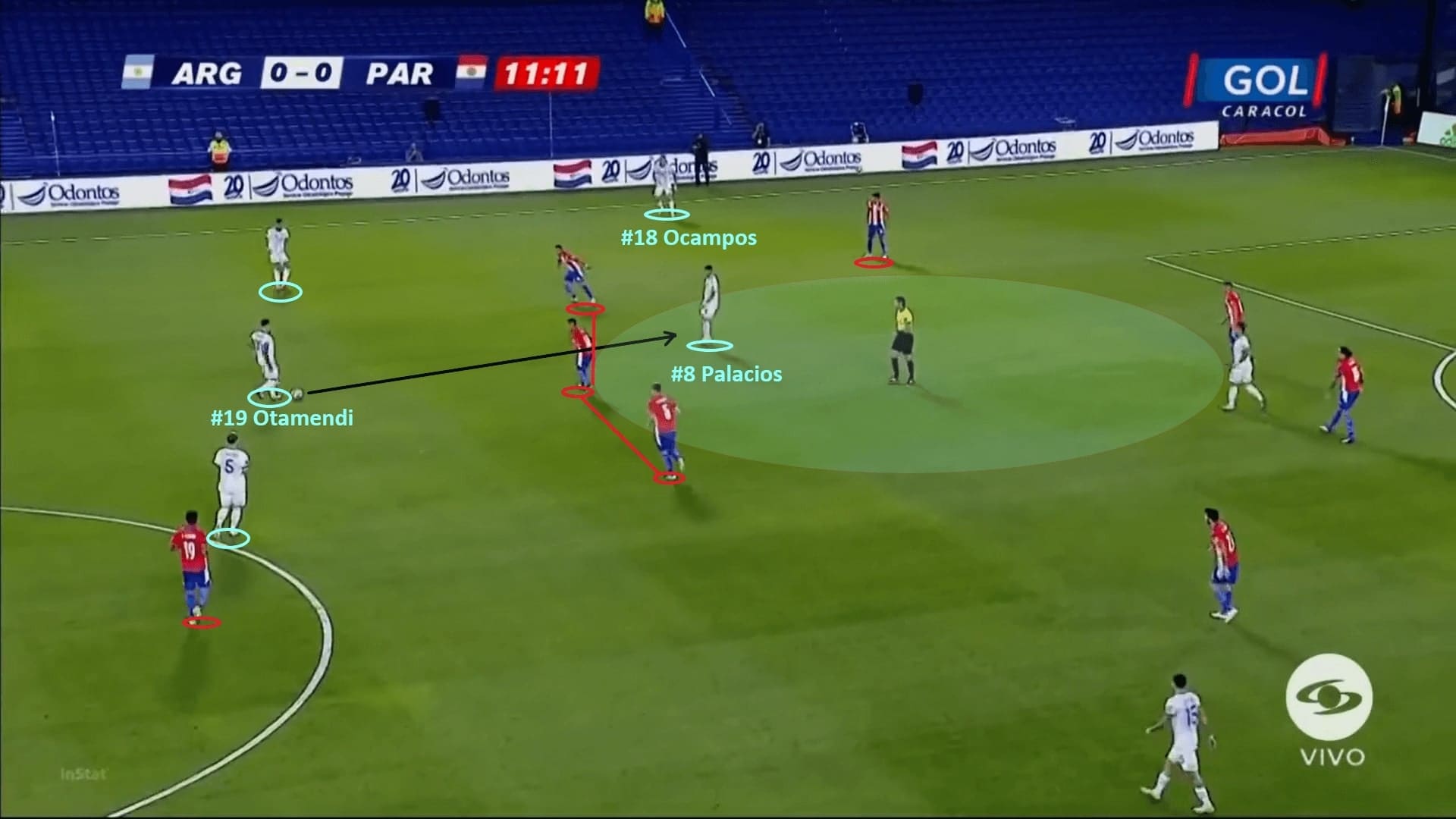
The only exception case would involve Messi. When Messi joined the attack on the strong side, Palacios should always be aware of not to compressing spaces. Therefore, he should move away from this zone under those circumstances.
The below example shows Messi appearing behind of the midfield. To leave those spaces opened, Palacios decided to stay deeper after a double-movement. This double layer of different offensive heights would create a decisional crisis for the defence as they could only defend one horizontal zone. The Paraguay players defended higher, so the passing lane to Messi was opened.
Even the inward pass instantly triggered the pressure from the backline as Messi was undoubtedly good enough to release Ocampos, who ran into zone 16.
Throughout these attacks, Lautaro Martínez also played a part by occupying the centre-backs. Despite intending to create an overload on the left, the Inter Milan striker never positioned himself wide too early. Instead, he always stayed between the centre-backs to keep them at the centre, ensuring the right-back was isolated against the winger.
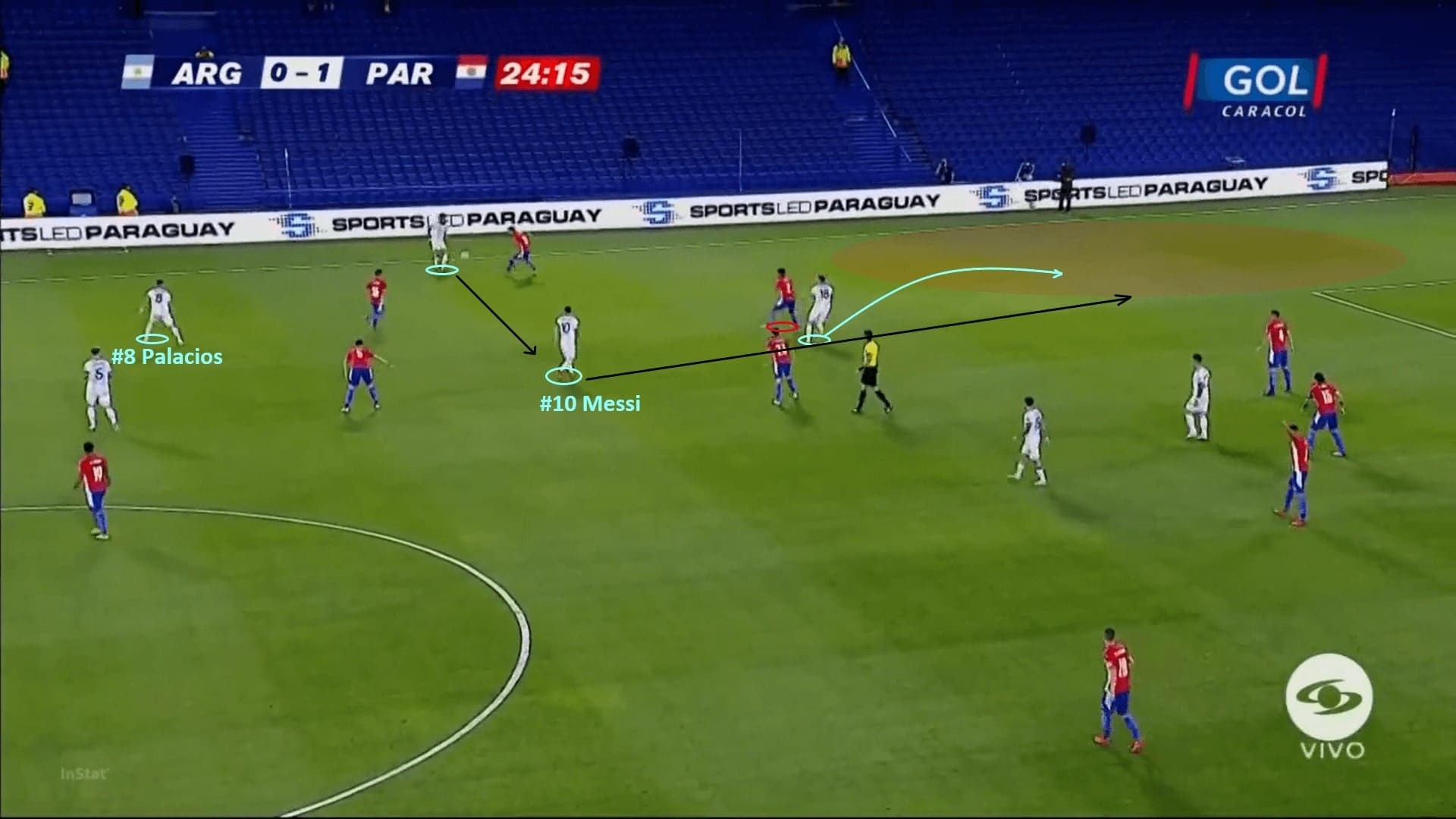
The contexts changed slightly after Palacios was injured and replaced by Lo Celso. The Tottenham midfielder would have liked to receive the ball deeper, rotating with Paredes as the temporary pivot on some occasions.
Since Paraguay’s players pressuring intensely at the centre of the pitch, even Messi faced difficulties to dribble past multiple players. The Barcelona star only completed 4 dribbles out of an attempted 9, and the 44% success rate was lower than his average of the season – 51%.
The below example shows Lo Celso’s positioning. He likes to drop in front of the defence to create spaces and angles for the next action. Ocampos was once again being released by the long pass, running into spaces behind the right-back.
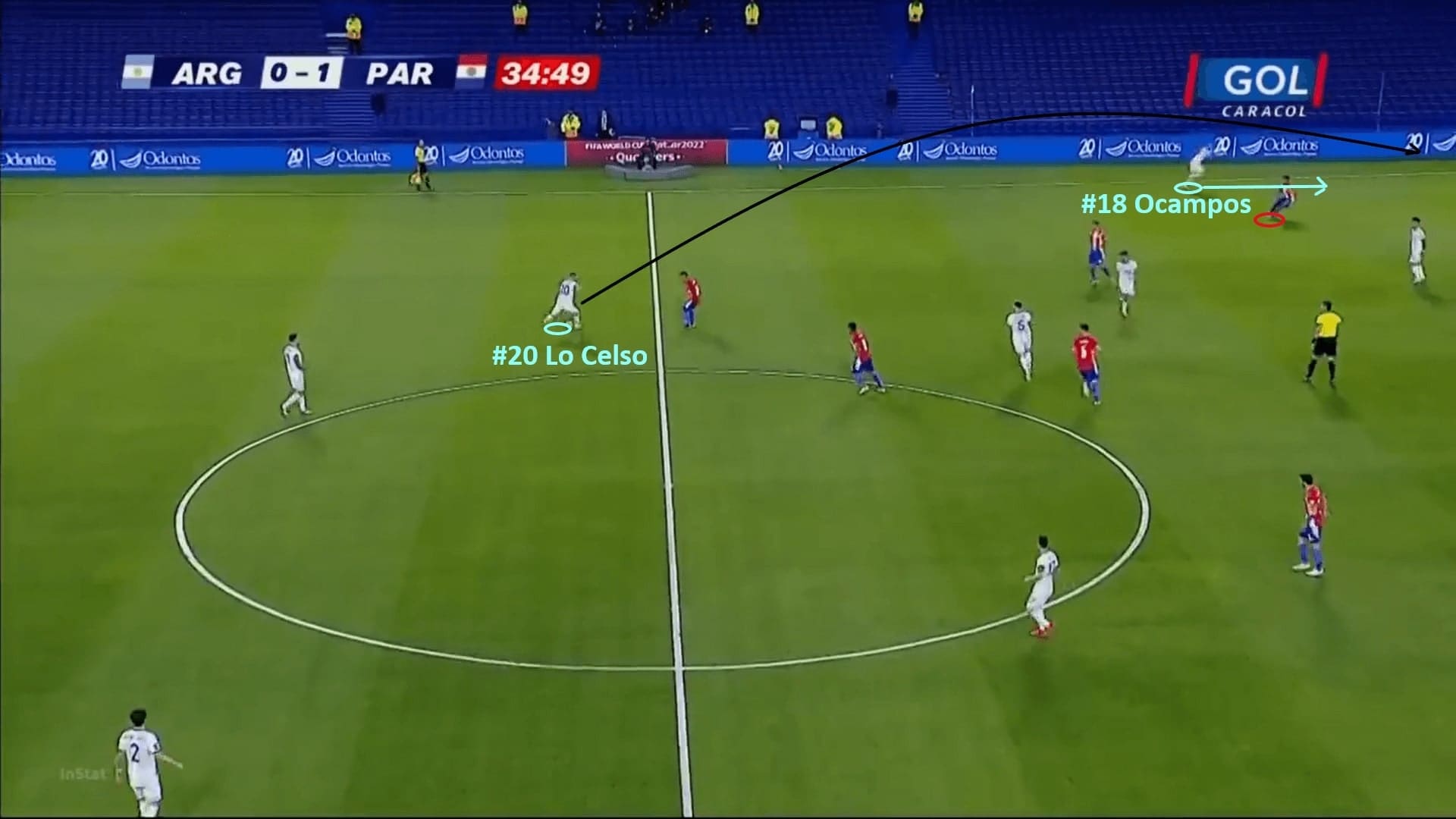
Strategic attacking point of Paraguay
Since Paraguay did not have the same quality of players as the opponents did, they did not insist on playing out from the back. Instead, Berizzo designed very simple patterns to attack the right flank of Argentina, which was quite successful in the first half and they won a penalty from it.
The height of Argentina’s engagement line depends on Messi as the Barcelona star would lead the press. In the first half, they were more passive to maintain a 4-4-2 midblock instead of committing numbers to press high. However, the areas to defend were large and it was difficult to cover all areas. In general, the likes of De Paul were slow to shift towards the flank when the attack developed widely.
Because of the loose vertical distance, Paraguay always enjoyed a 3 v 2 numerical advantage in the first phase. They split the centre-back while adding a pivot as an additional layer, dropping the advanced midfielder – Gastón Giménez, to progress. The structure at the centre always generated a passing triangle at the backline and it was too large for Lautaro and Messi to catch the ball.
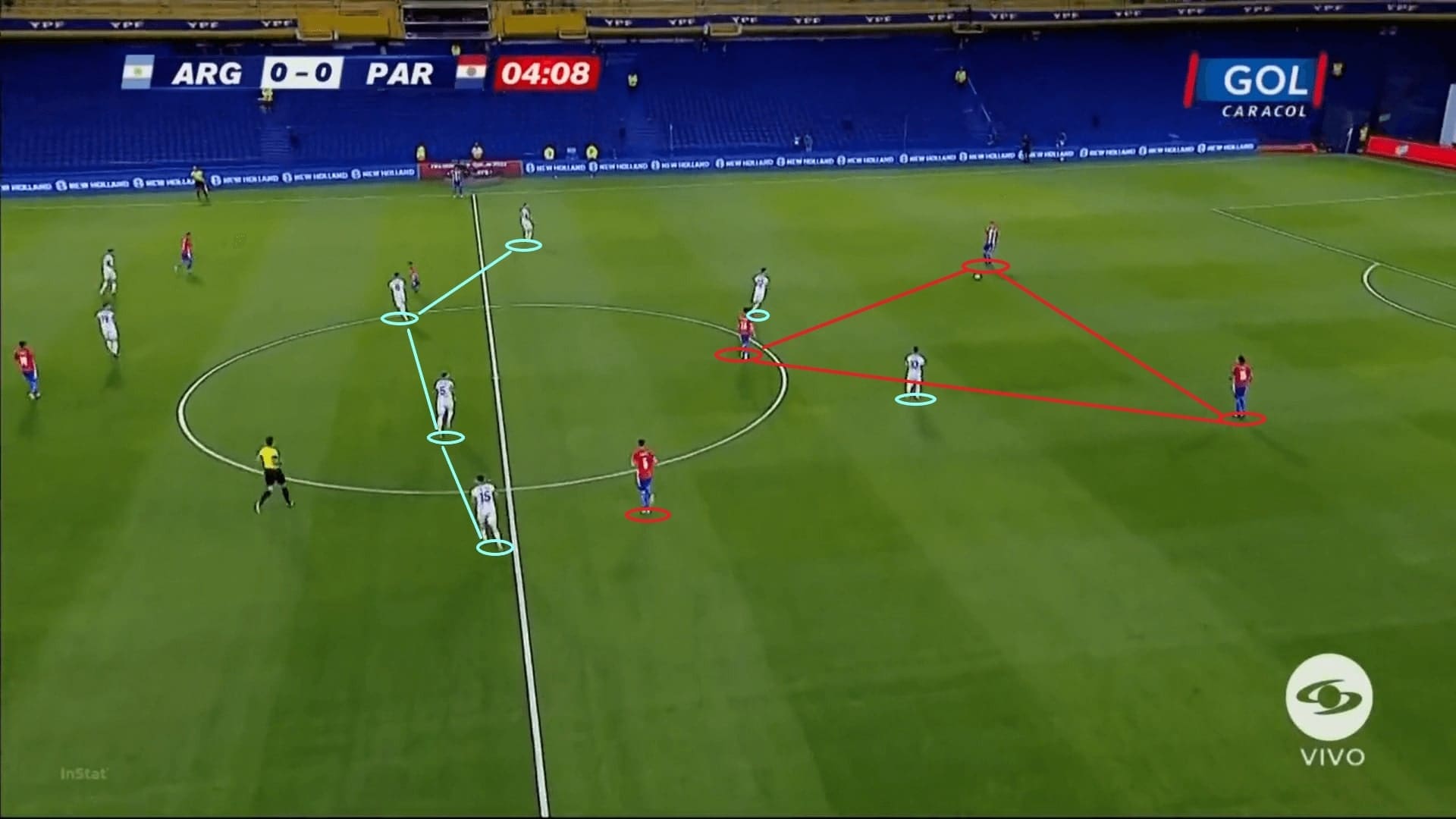
The pattern of attack was Gustavo Gómez -> Júnior Alonso -> Giménez or Miguel Almirón, depending on the positioning of the attack. If they were moving the ball at the backline, then Giménez could receive the ball at the half-spaces. Paraguay enjoyed a 2 v 1 numerical overload on De Paul in this area as Paredes was defending much deeper in the pressing.
Also, they capitalised on Messi’s light defensive duties. It was easy to bypass the first line as the Barcelona star seldom tracked back if the first wave of pressure failed. Here, Messi tried to press Gómez but was late to the ball, Alonso was found, and Messi was reluctant to press the Paraguay midfielder despite the fact that it was an accessible distance. The attack was carried on at this side easily.
De Paul was always late to press the left-back as he was often defending centrally. In the first half an hour, Argentina were yet to find the solutions to prevent the oppositions from constructing the attack.
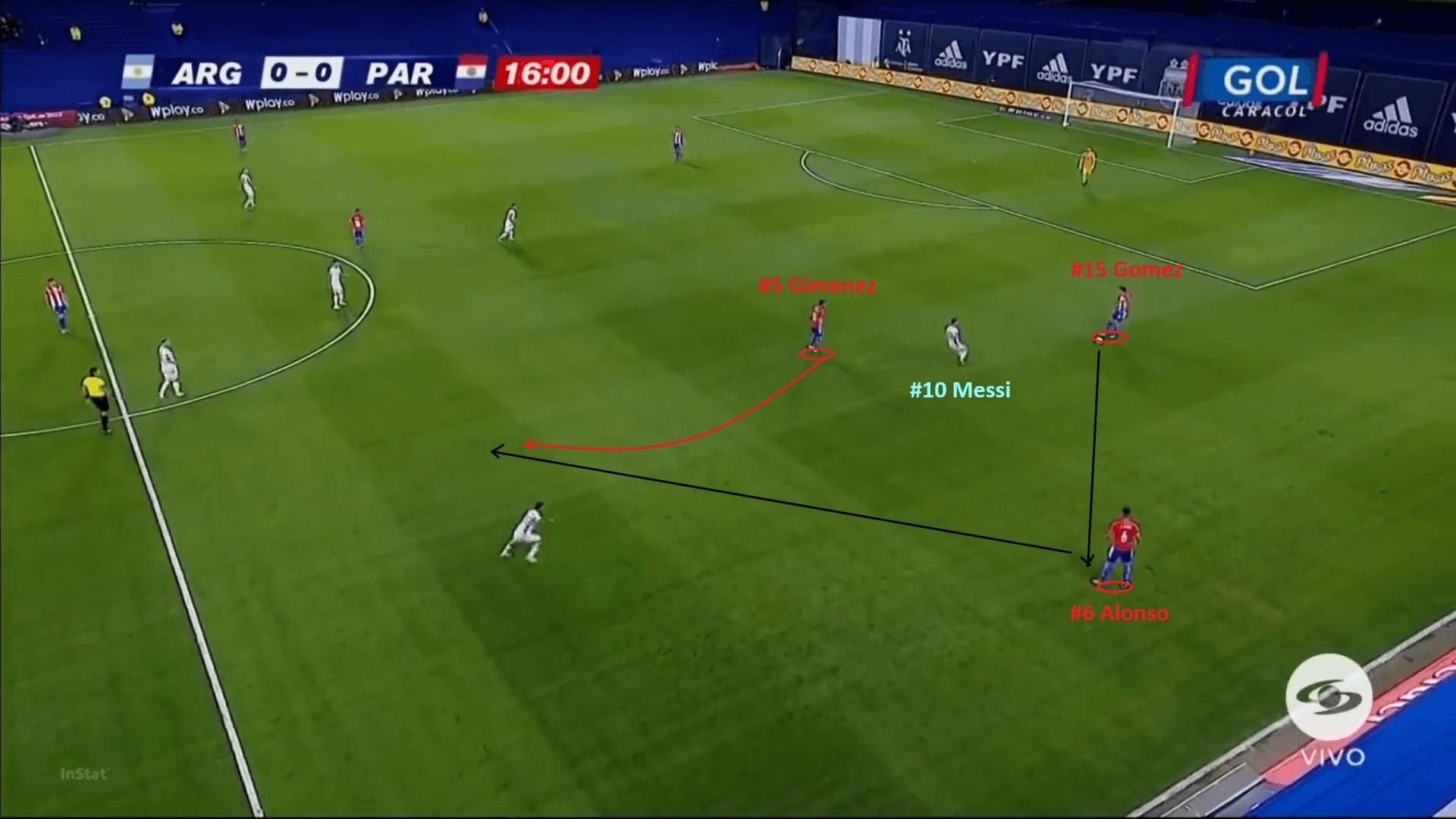
If Paraguay constructed the attack in higher positions, the objective was simple – release Almirón. The Newcastle United player was the left-winger in this game, who always came deeper to pull Gonzalo Montiel out of position. Spaces were created behind the right-back as a result, allowing Almirón to attack depth.
In other words, Montiel was isolated because of following Almirón early. It was a tough task for the right-back to defend a pacey player in big spaces. Meanwhile, his teammates did not provide enough support in the first half. In this image, Messi did not even try to stop Alonso to bring the ball forward, allowing the opposition to bypass the first line very easily.
De Paul was once against late to the ball again because of his initial central positioning as it took huge distances to access the wide players. Paraguay had some joy in attacking down this flank in the early stages.
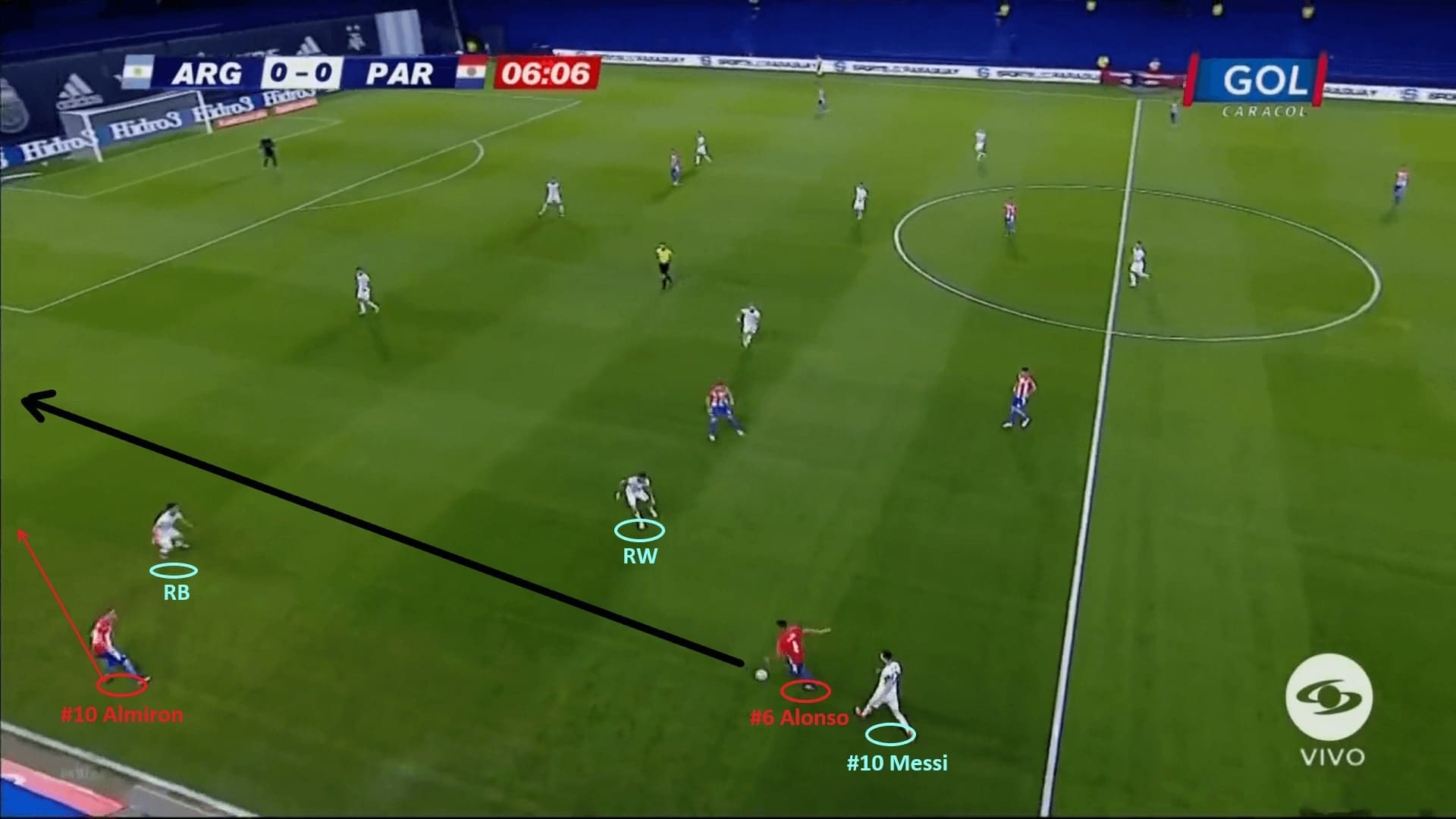
This tactic indirectly helped Paraguay to score the first goal, and all could be attributed to the below image.
Alonso received the ball over the first line without confronting any pressure, supported by Almirón who stayed deeper to pull Montiel out of position. Spaces were created behind the right-back while there was a Paraguay player running into it.
In fact, Paredes could do better in this situation. Since Argentina tended to defend zonally, the Paris Saint-Germain should communicate with Otamendi to clarify who was going to cover those spaces. These two players just went into the same zone, leaving the Argentinian right half-spaces opened. Consequently, no one could pressure Almirón when he carried the ball inward – Montiel was not anticipating that action. The Paraguayan simply reached the box and won the penalty.
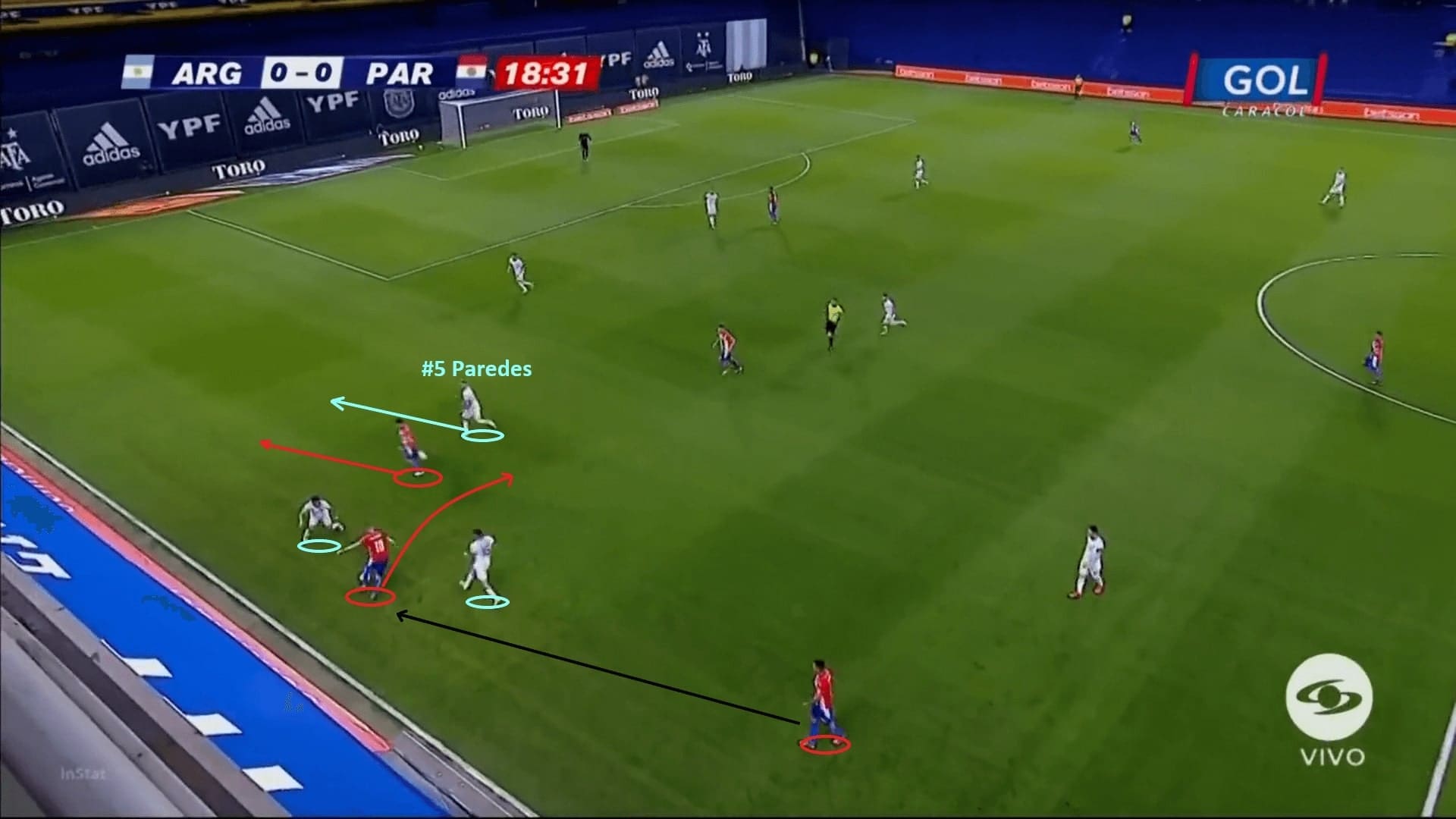
Adjustments of Scaloni after the break
Argentina wanted to win this game to make it three in a row in the competition. As there were some issues as explained in the above analysis, Scaloni and his coaching staff instructed the players to play differently in the second half.
In order to control the game, Argentina had to pressure the opponents higher to try winning the ball as quick as possible. Therefore, the team placed a higher engagement line to press the opposition backline, abandoning the passive midblock in the first half. The continuous pressure on the opponent forced more long balls, allowing the hosts to regain the ball as Paraguay were without a target.
The change of the pressuring intensity was demonstrated in the below PPDA graph of Argentina. In the first 30 minutes, the figure fluctuated between 20.7 to 15, but this suddenly decreased to 4.8 to 7.5 afterwards.
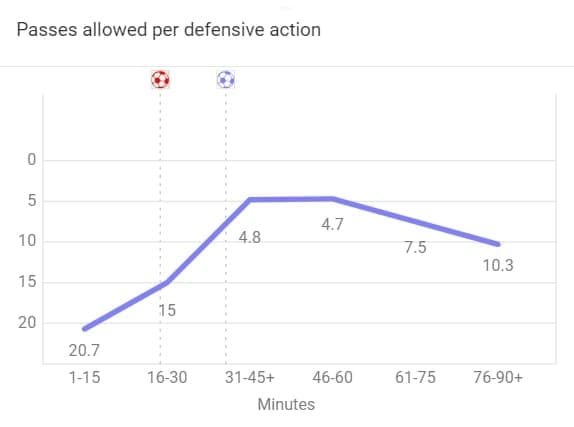
The Argentine mostly committed five to six players to press high, leaving Paredes or a winger to protect spaces in front of the back four. The below still shows Paredes pushing high to close the opposition midfielder, so the other midfielder and Lo Celso were deeper to prevent a diagonal switch.
Messi also involved in the defensive game more often by initiating the press on the centre-back and was supported by the wingers. The wingers would press outside-in to keep the full-backs under shadows.
Paraguay’s players could not cope with the increased tempo when confronting pressure – they were more prone to play long. Also, the Argentinian right-wingers (Ángel Di María and Ocampos) were getting tight to Alonso very early, so Paraguay could not attack with the same pattern as they did in the first half. Argentina gained more control in the second half because of this change.
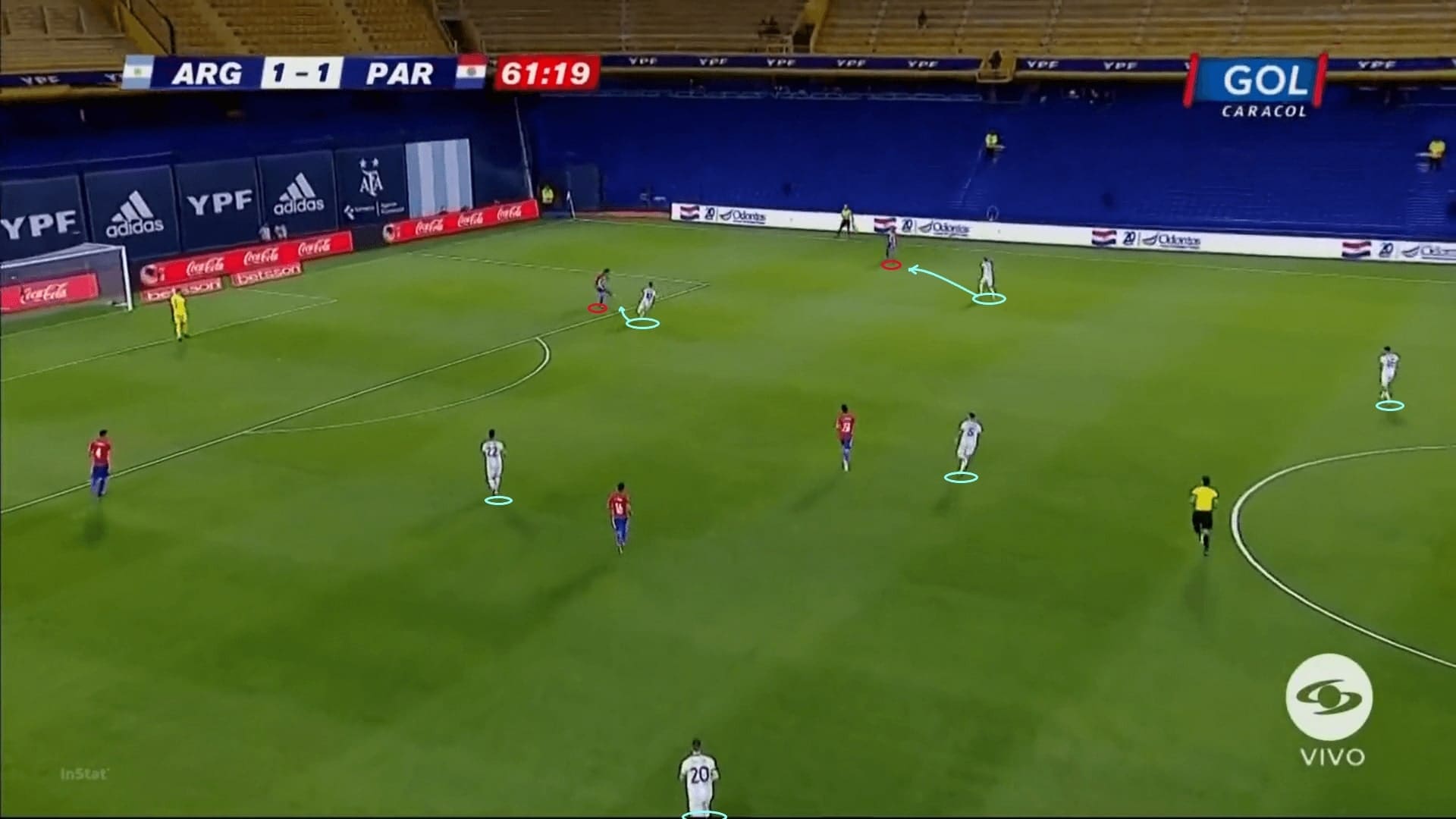
While in the offensive phase, the most obvious change was González’s initial position. The left-back pushed into an advanced position very early, staying behind the winger to create a 2 v 1 overload on the right-back. At the meantime, Lo Celso was now the left-winger as Scaloni wanted De Paul to drop alongside Paredes in the build-up. The Tottenham player was a “false-winger”, operating at the half-spaces to leave the wide zone for the left-back. This was easier to produce crosses on the left.
Only one Paraguay right-back struggled to cope with both wide players. It was always a decisional crisis as he had to decide to mark either one player. Argentina nearly scored another because of this change, as shown in the below example.
The right-back decided to take one step forward to close Lo Celso, resulted in leaving spaces behind. González was very early to stay on the same horizontal zone with the left-winger creating the overload and then released Otamendi’s pass.
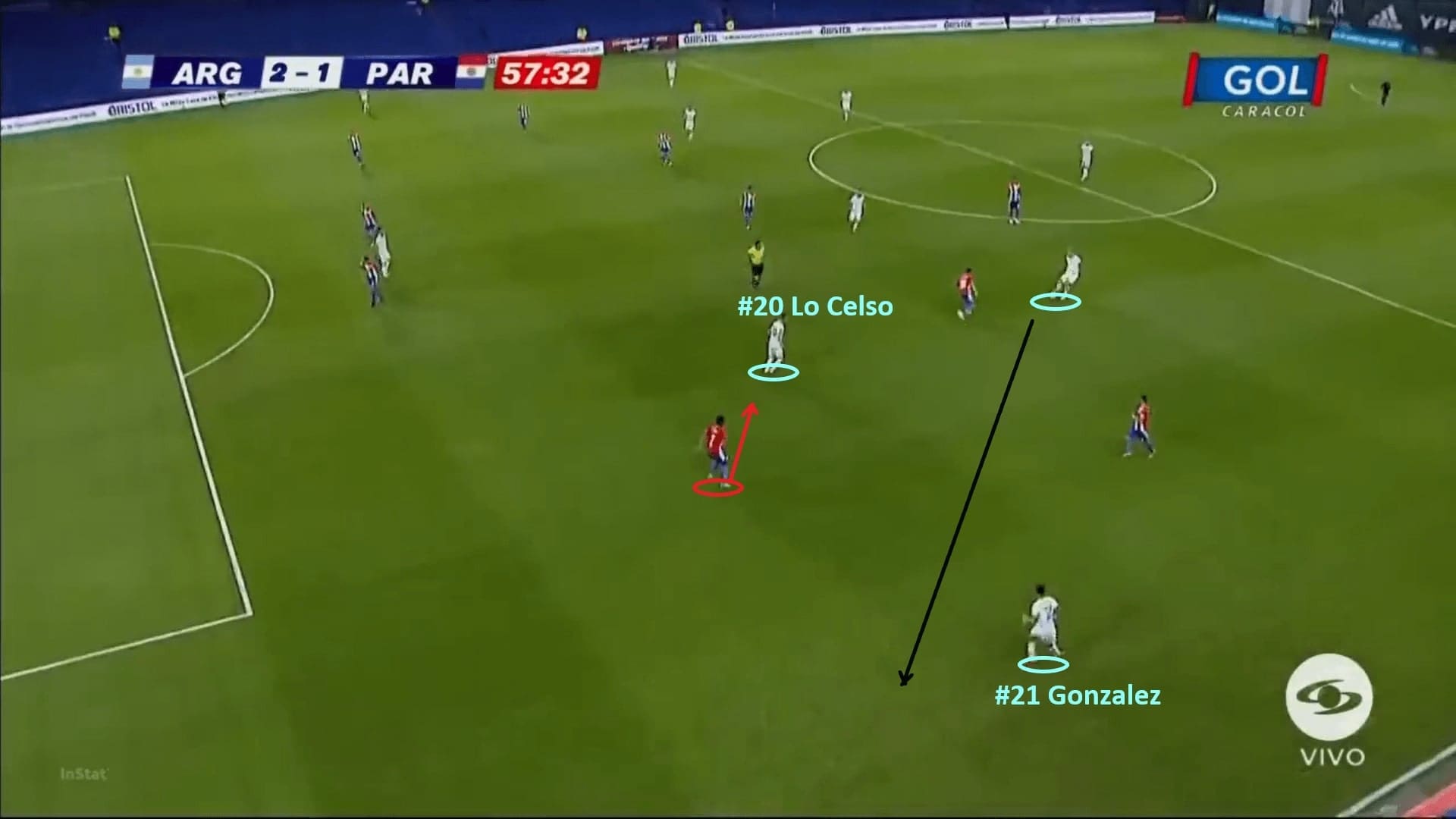
On the right, Argentina were attacking with more combinations due to playing multiple right-wingers on this flank. Apart from Montiel and Di María, De Paul also kept roaming into this zone to create passing triangles and overloads. As shown below, even though Messi was not moving wide, Argentina still had enough players to pass and move the ball and options were easily generated because of the support around.
Lautaro, as always, shall lurk around the centre-backs to look for the opportunities. He was joined by Lo Celso, the “false-winger”, to attack the penalty box in this example. Argentina attacked both flanks with dynamism in the second half which created several half-chances to score. Better crossing or the timing to attack the box were needed to make the efforts count.
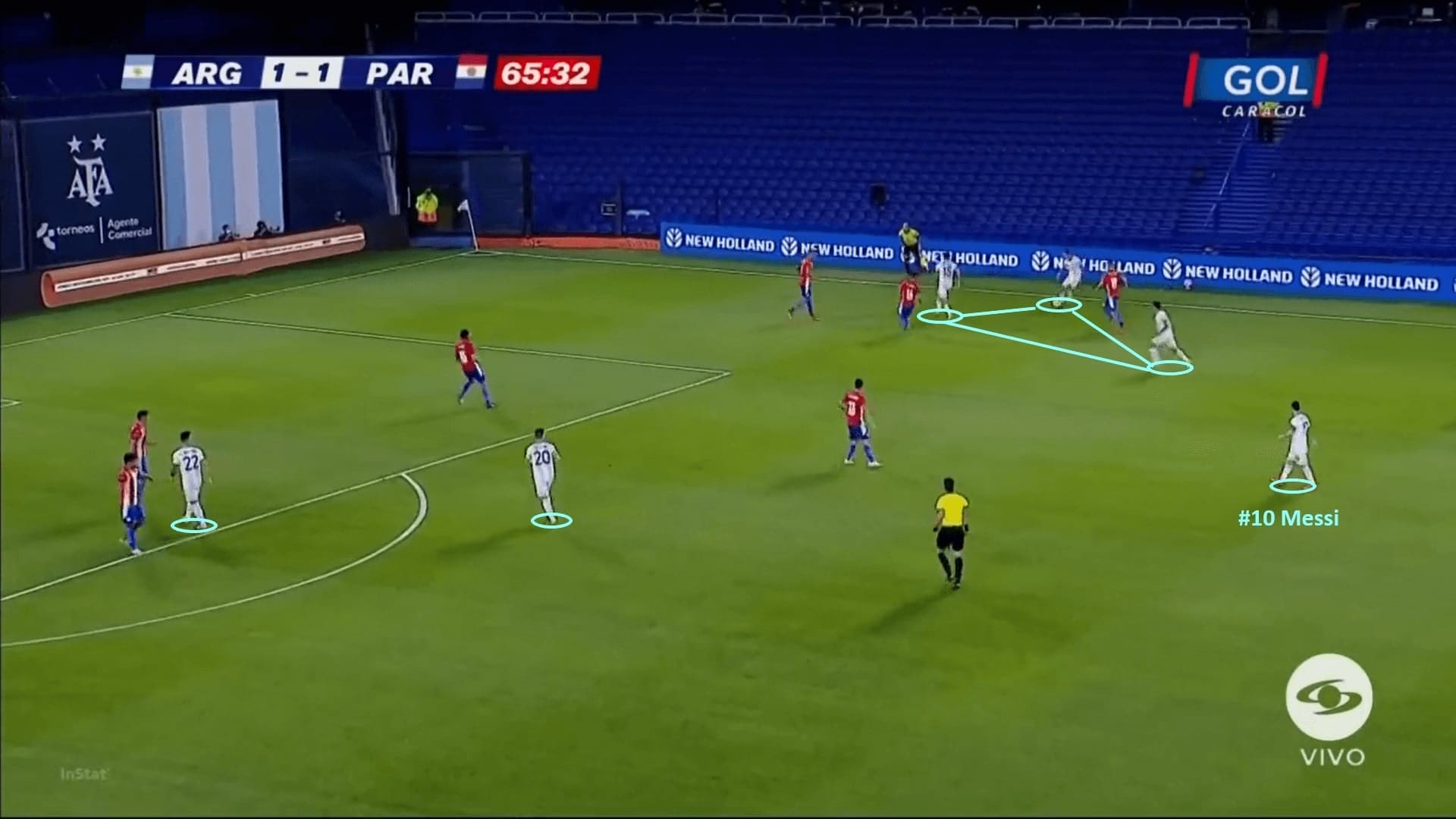
Final remarks
Apart from the González goal, most of Argentina’s opportunities were half-chances, but Lautaro should have scored after the keeper was mispositioned at the 49th minute – it was a chance carrying 0.18 xG. Scaloni’s side did not look much better than they did in the previous games, and they will have to work harder to try to gain three points against Peru days later.
Paraguay did not create a lot either. Their xG was only 0.32 from three shots if the penalty was excluded. Although they succeeded to win the penalty through the designated offensive setups, more efforts in this phase are needed to create more chances in the future.





Comments